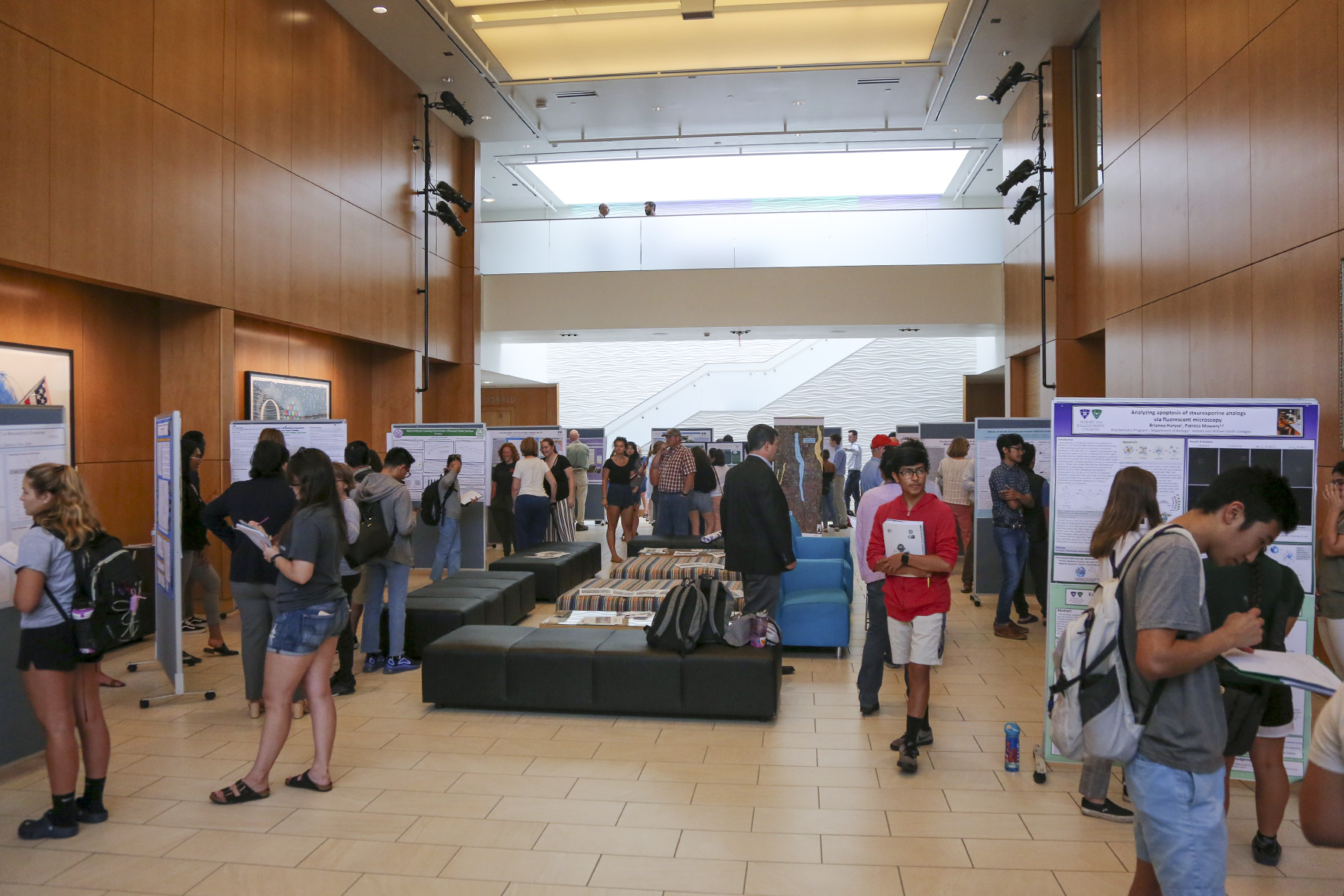
HWS News
4 October 2019 • Research Student Research Symposium
Over the summer, more than 50 students completed research alongside faculty members, investigating cutting-edge research topics ranging from cancer-killing compounds to the prevalence of Islamophobia in religious communities, and the science behind tie-dying your clothes. During Homecoming and Family Weekend, students shared the breadth of their intellectual pursuits with peers, families and faculty members at the Student Research Symposium.
Through their research positions, students are provided with financial support to live and work on campus. Often, the research is published in scholarly journals and serves as the foundation for Honors projects.
Under the guidance of Associate Professor of American Studies Elizabeth Belanger, Lorena Robelo-Lara ’21 and Lalaine Vergara ’21 developed a narrative record of students’ experiences in the classroom due to diverse family histories and identities. Their research, titled “The Colors of Silence: Family Histories and Identities Translated into Classroom Dynamics in Predominantly White Institutions” was instrumental in teaching Robelo-Lara how diverse backgrounds shape peoples’ experiences.
Student Research Symposium
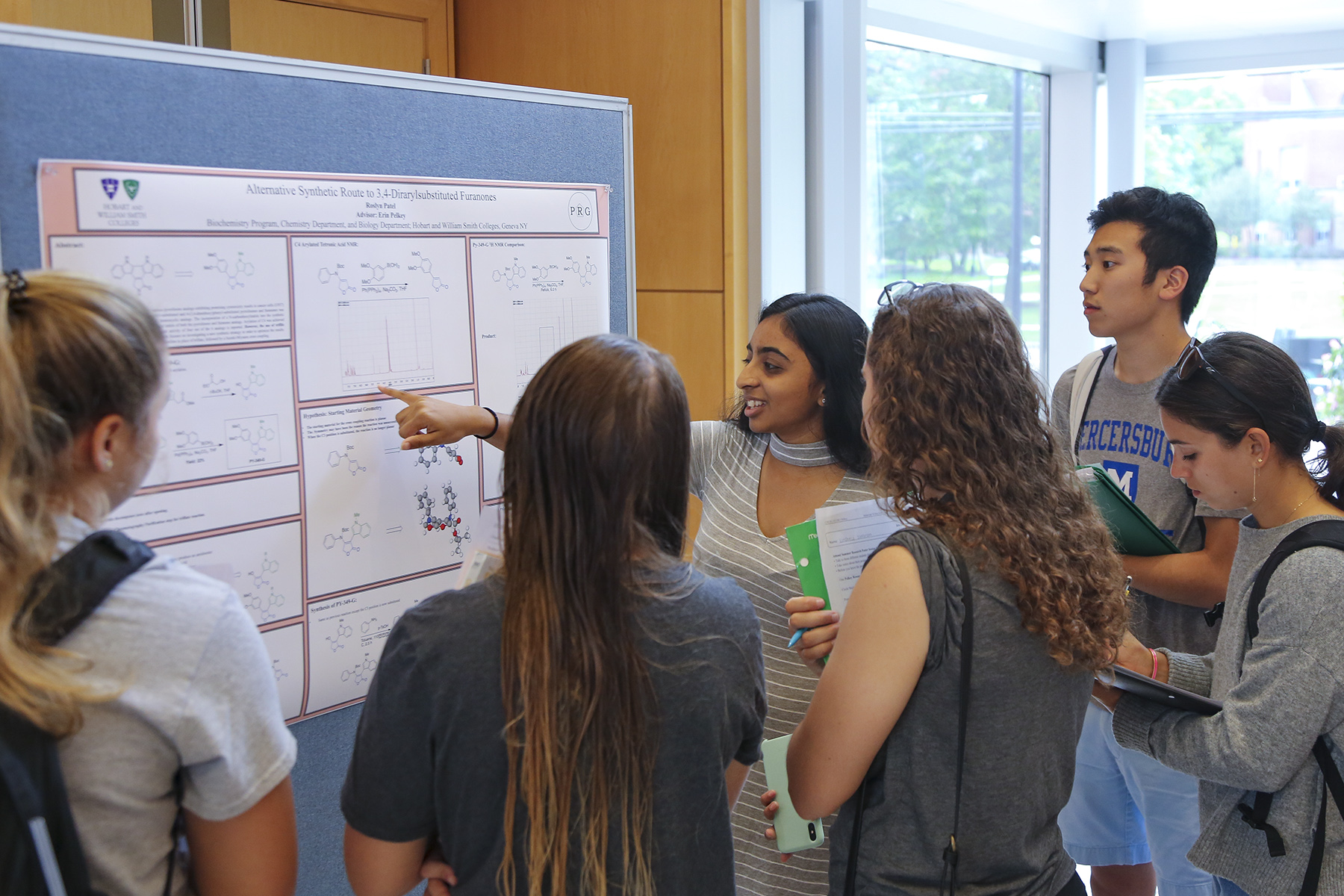 Roslyn Patel ‘20 presents her research project titled, "Alternative Synthetic Rout to 3,4-Dirarylsubstituted Furanones."
Roslyn Patel ‘20 presents her research project titled, "Alternative Synthetic Rout to 3,4-Dirarylsubstituted Furanones."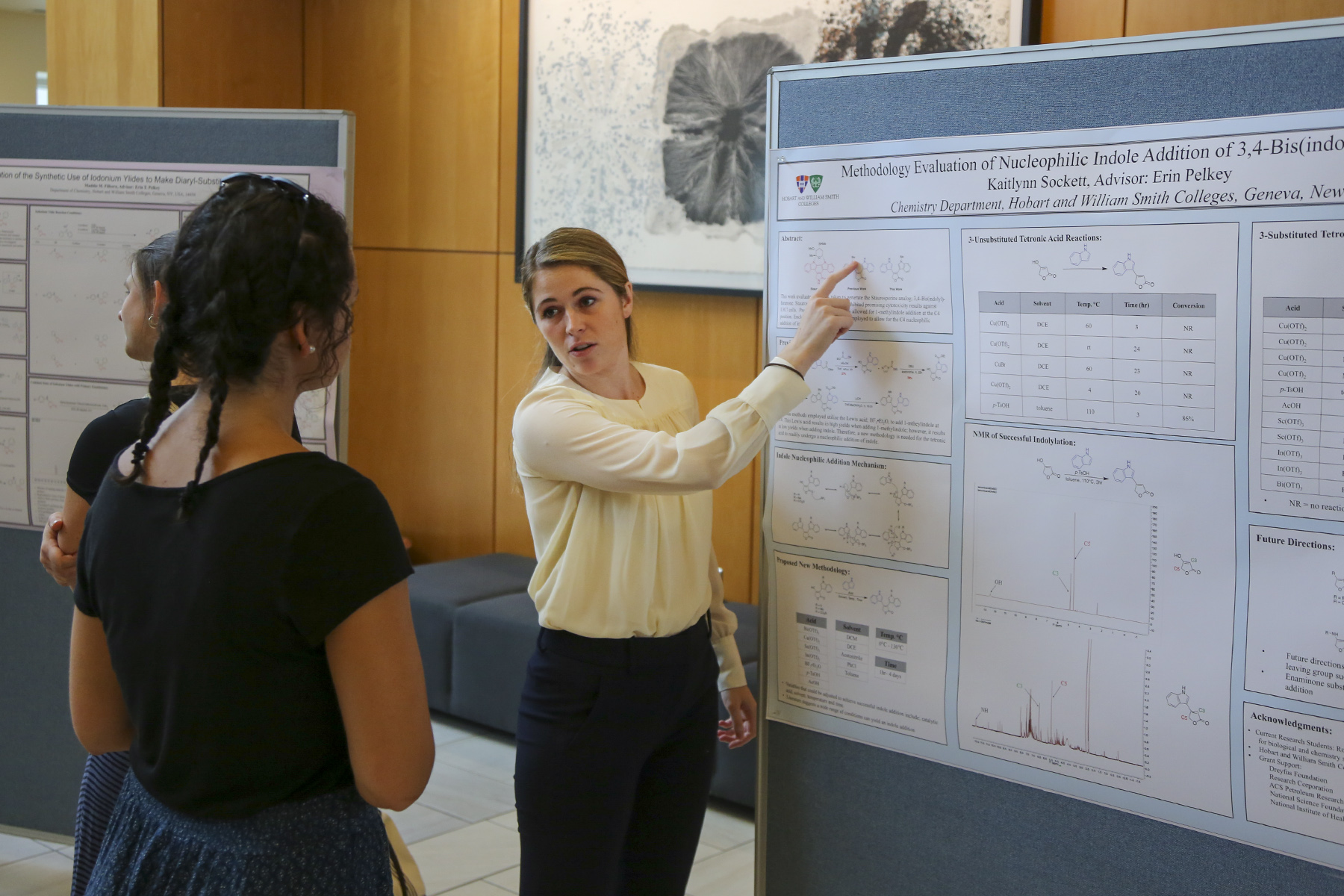 Kaitlynn Sockett ‘20 presents her research project titled, "Methodology Evaluation of Nucleophilic Indole Addition of 3,4-Bis(indoyl)-Furanone."
Kaitlynn Sockett ‘20 presents her research project titled, "Methodology Evaluation of Nucleophilic Indole Addition of 3,4-Bis(indoyl)-Furanone."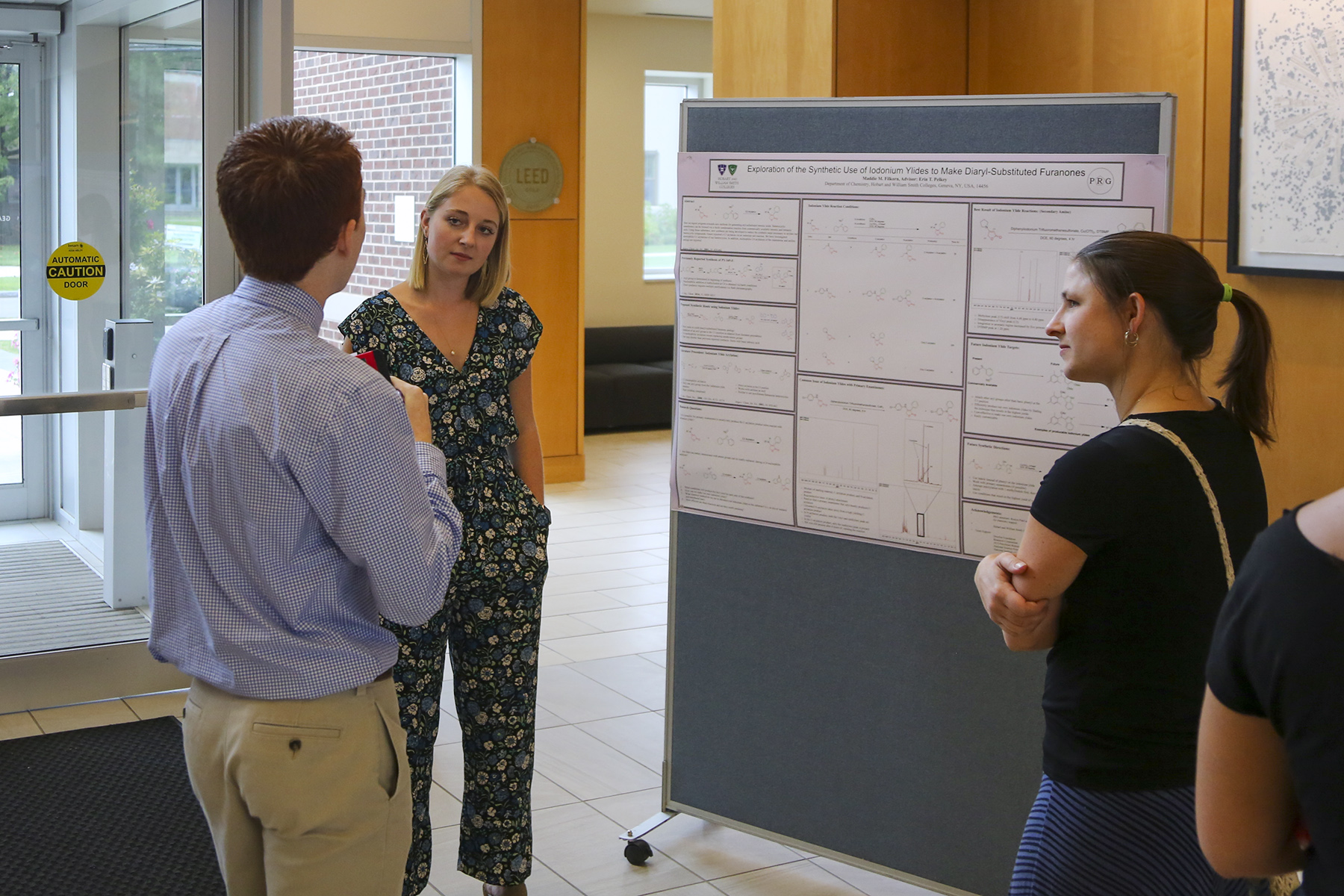 Maddie Filkhorn '21 presents her research project titled, "Exploration of the Synthetic Use of Iodonium Ylides to Make Diaryl-Substituted Furanones."
Maddie Filkhorn '21 presents her research project titled, "Exploration of the Synthetic Use of Iodonium Ylides to Make Diaryl-Substituted Furanones."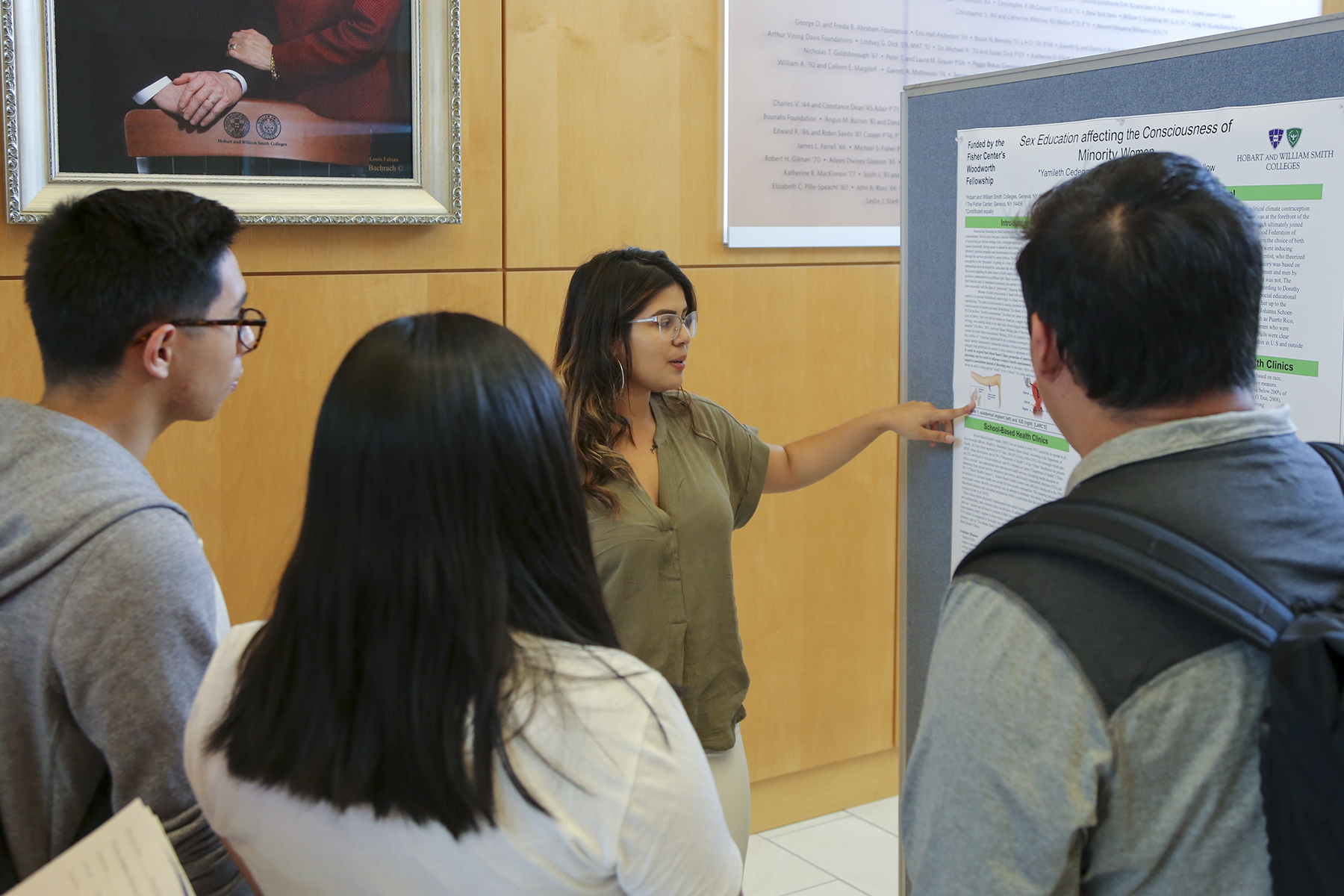 Yamileth Cedeno ’20 speaks to fellow students about her research project titlted, "Sex Education affecting the Consciousness of Minority Women."
Yamileth Cedeno ’20 speaks to fellow students about her research project titlted, "Sex Education affecting the Consciousness of Minority Women."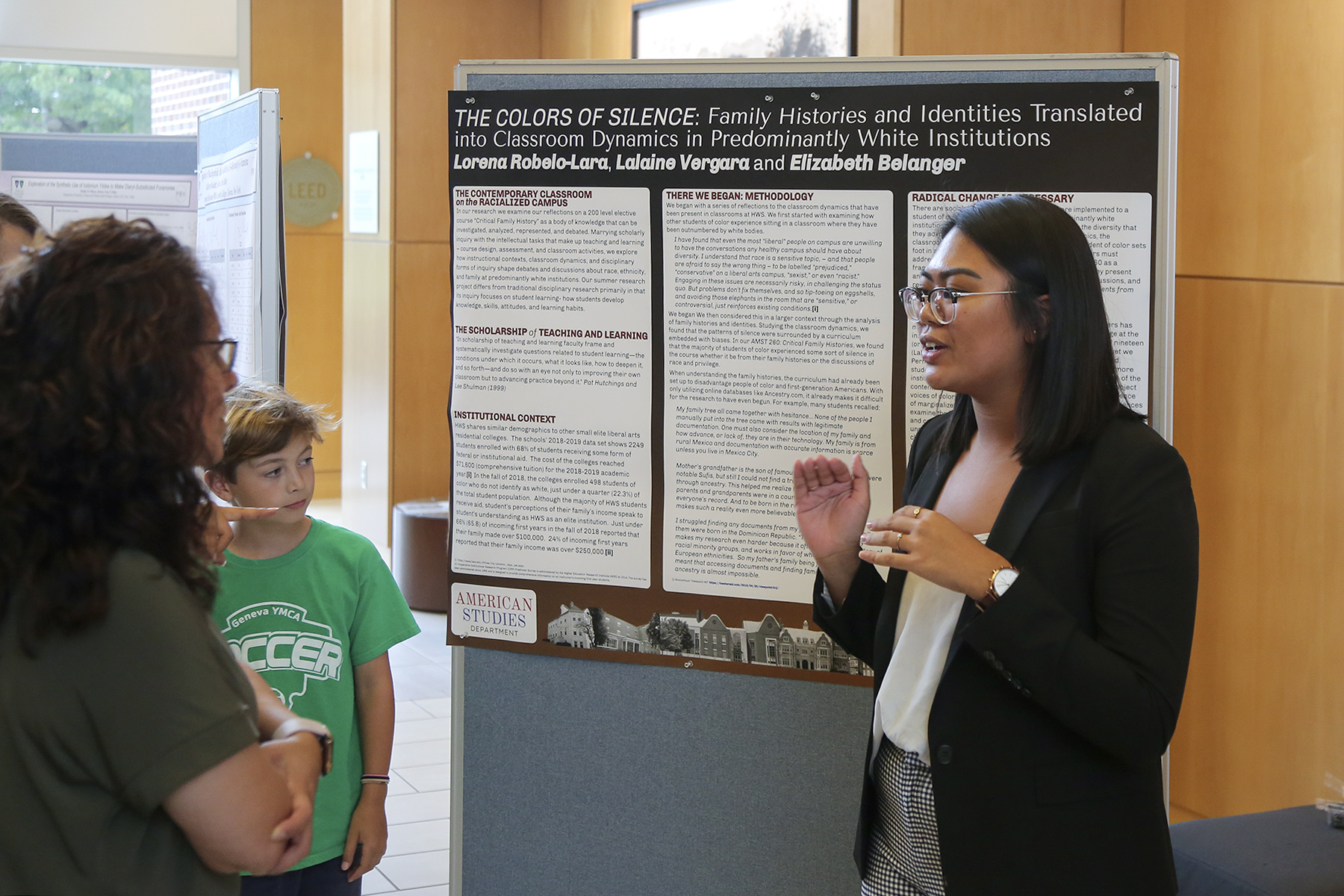 Lalaine Vergara discusses her research project titled, "The Colors of Silence: Family Histories and Identities Translated into Classroom Dynamics in Predominantly White Institutions.
Lalaine Vergara discusses her research project titled, "The Colors of Silence: Family Histories and Identities Translated into Classroom Dynamics in Predominantly White Institutions.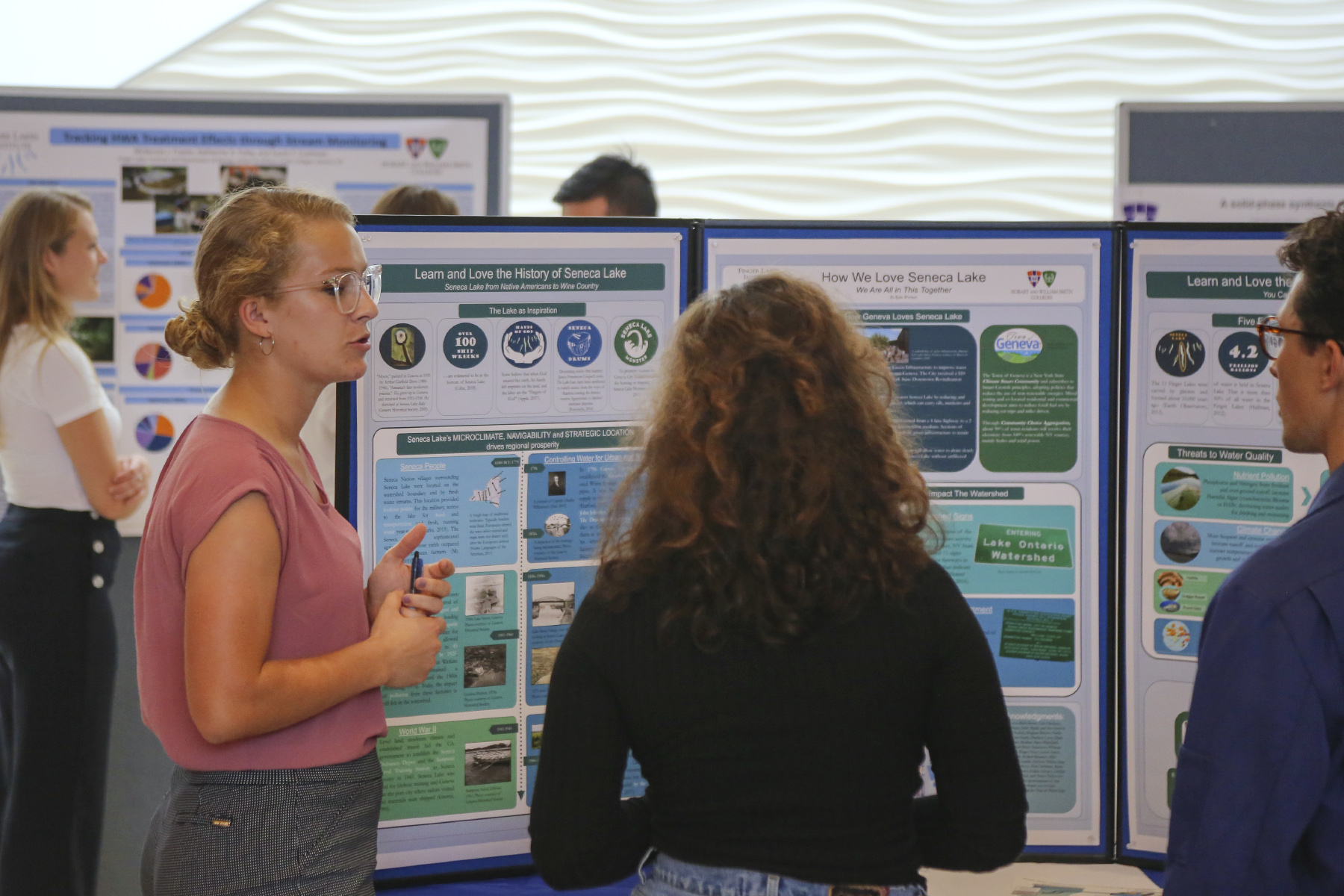 Rylee Wernoch '21 presents her research project titled, "How We Love Seneca Lake."
Rylee Wernoch '21 presents her research project titled, "How We Love Seneca Lake."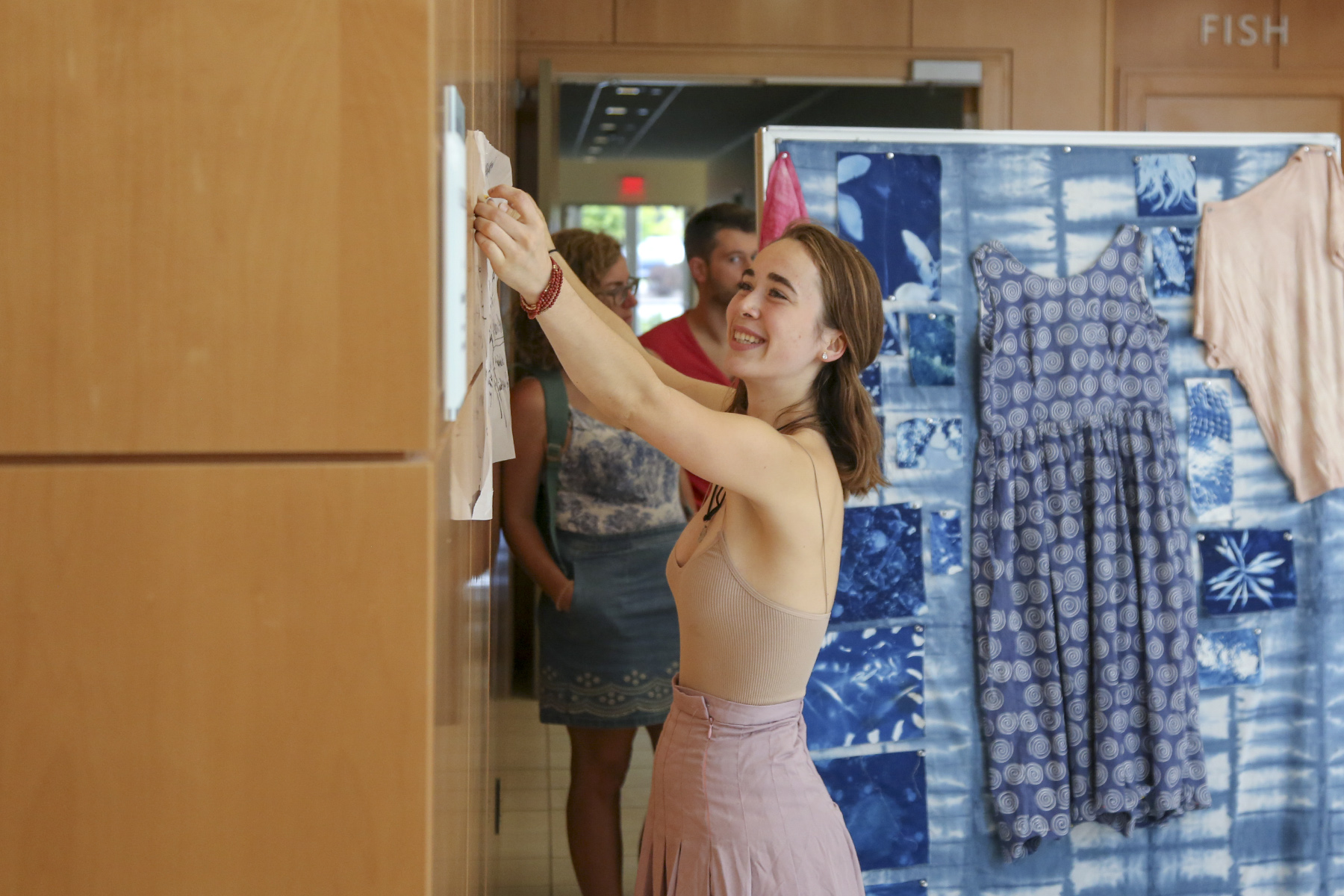 Grace Hammett ’20 sets up her research project.
Grace Hammett ’20 sets up her research project.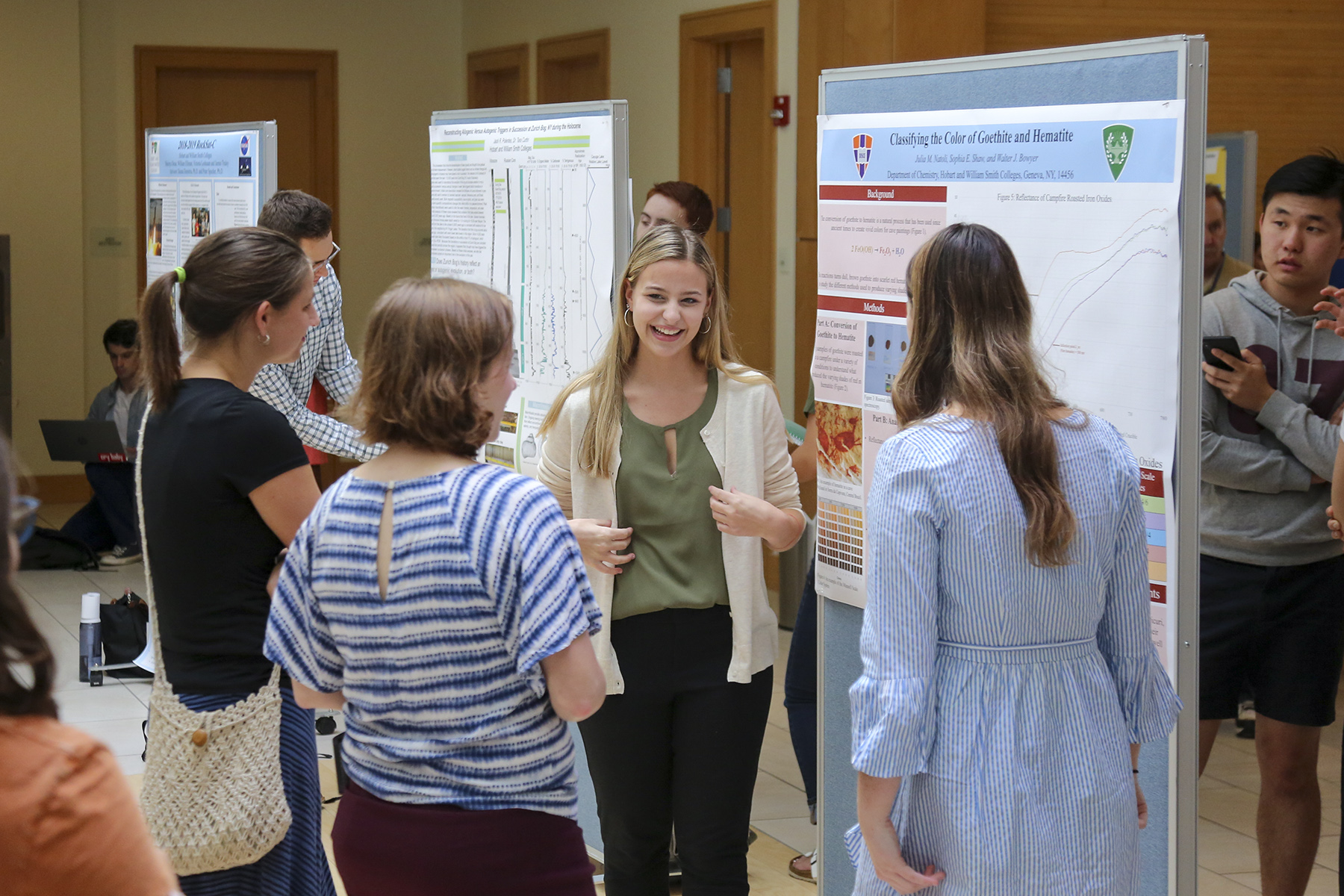 Julia Natoli '21 discusses her research project titled, "Classifying the Color of Goethite and Hematite."
Julia Natoli '21 discusses her research project titled, "Classifying the Color of Goethite and Hematite."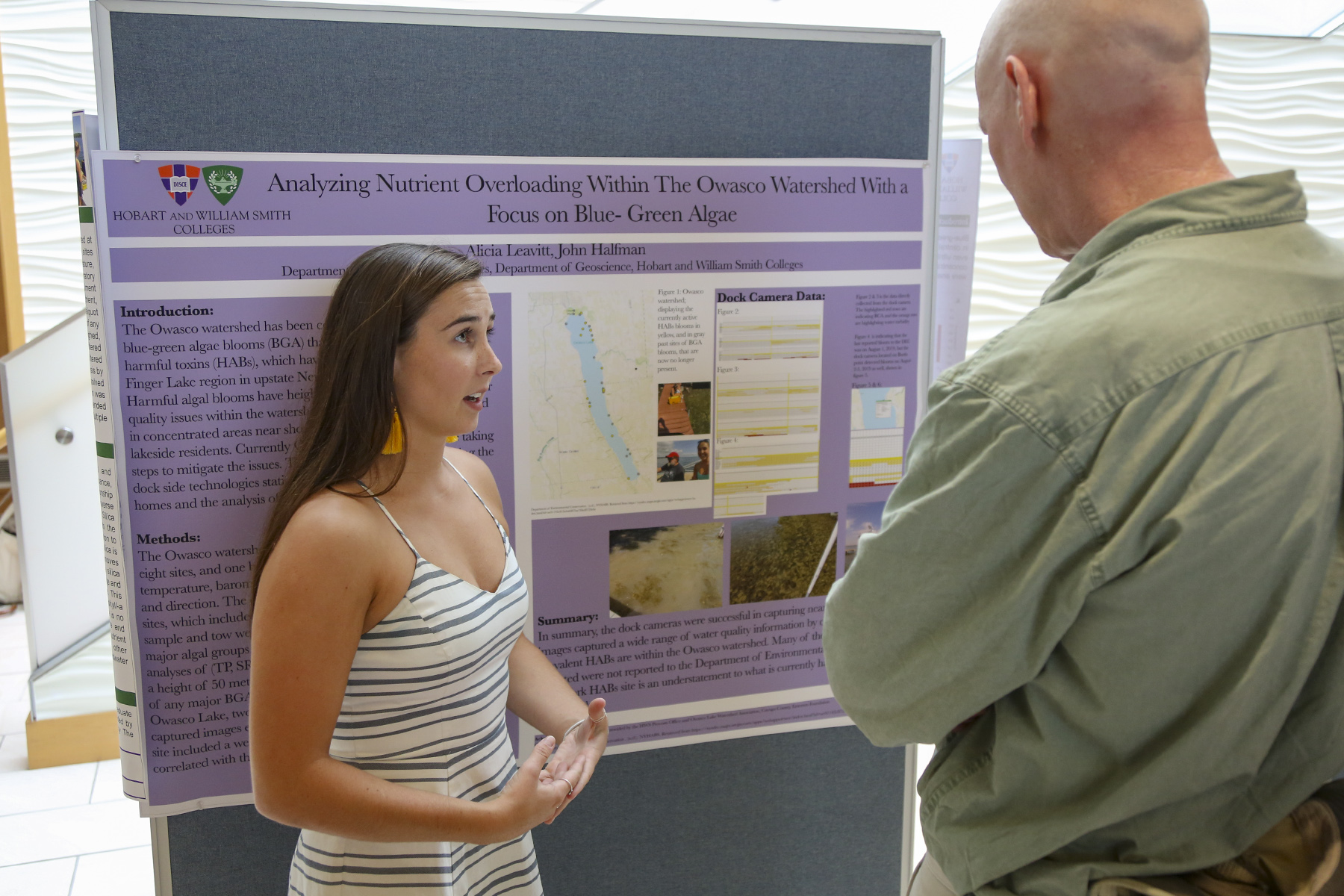 Alicia Leavitt '20 discusses her research project titled, "Analyzing Nutrient Overloading Within the Owasco Watershed" with Professor of Chemistry Walter Boyer.
Alicia Leavitt '20 discusses her research project titled, "Analyzing Nutrient Overloading Within the Owasco Watershed" with Professor of Chemistry Walter Boyer.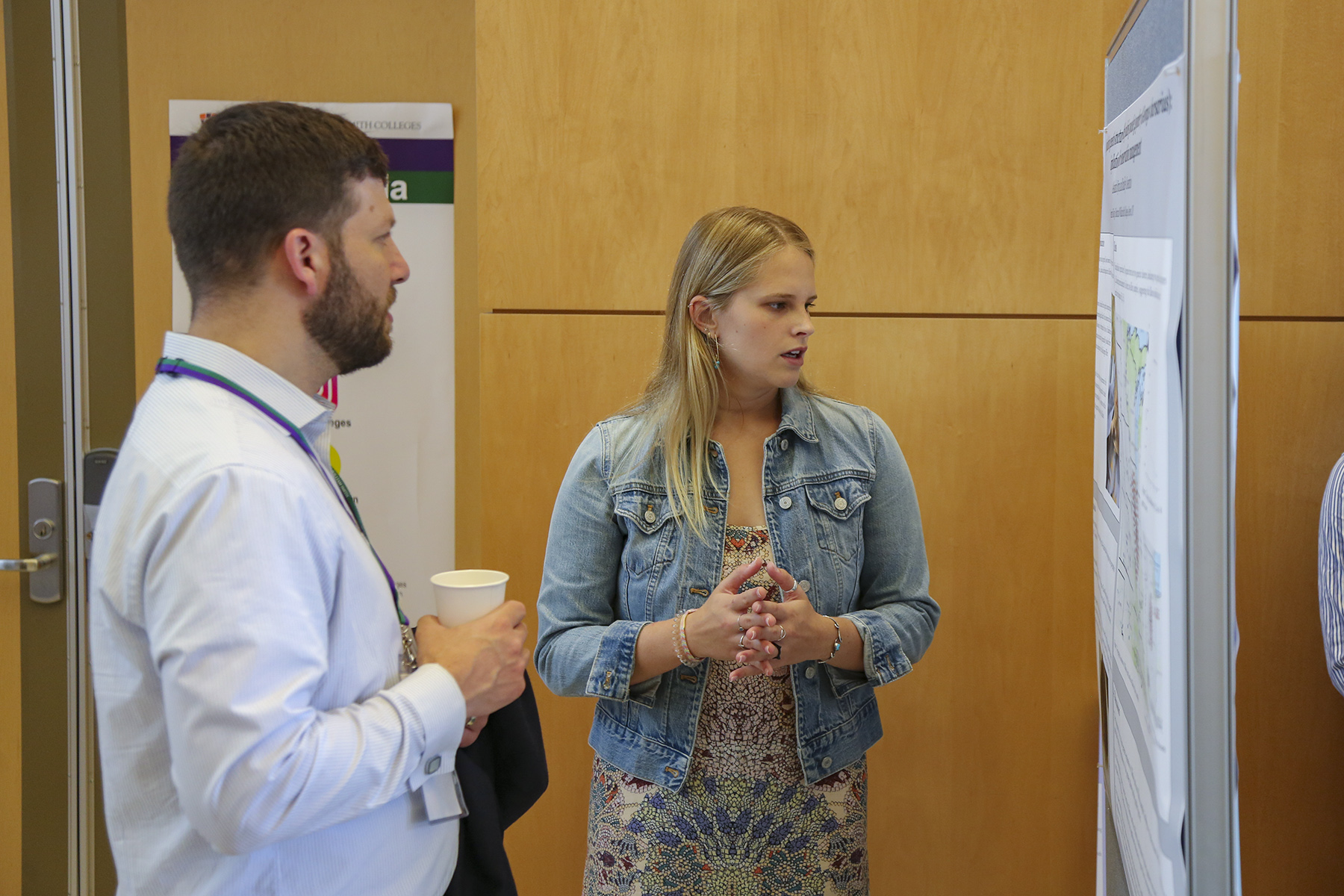 Ally Bryan '19 presents her research project titled, "Population genetic structure of the plains pocket gopher (Geomys bursarius): implications for conservation management."
Ally Bryan '19 presents her research project titled, "Population genetic structure of the plains pocket gopher (Geomys bursarius): implications for conservation management."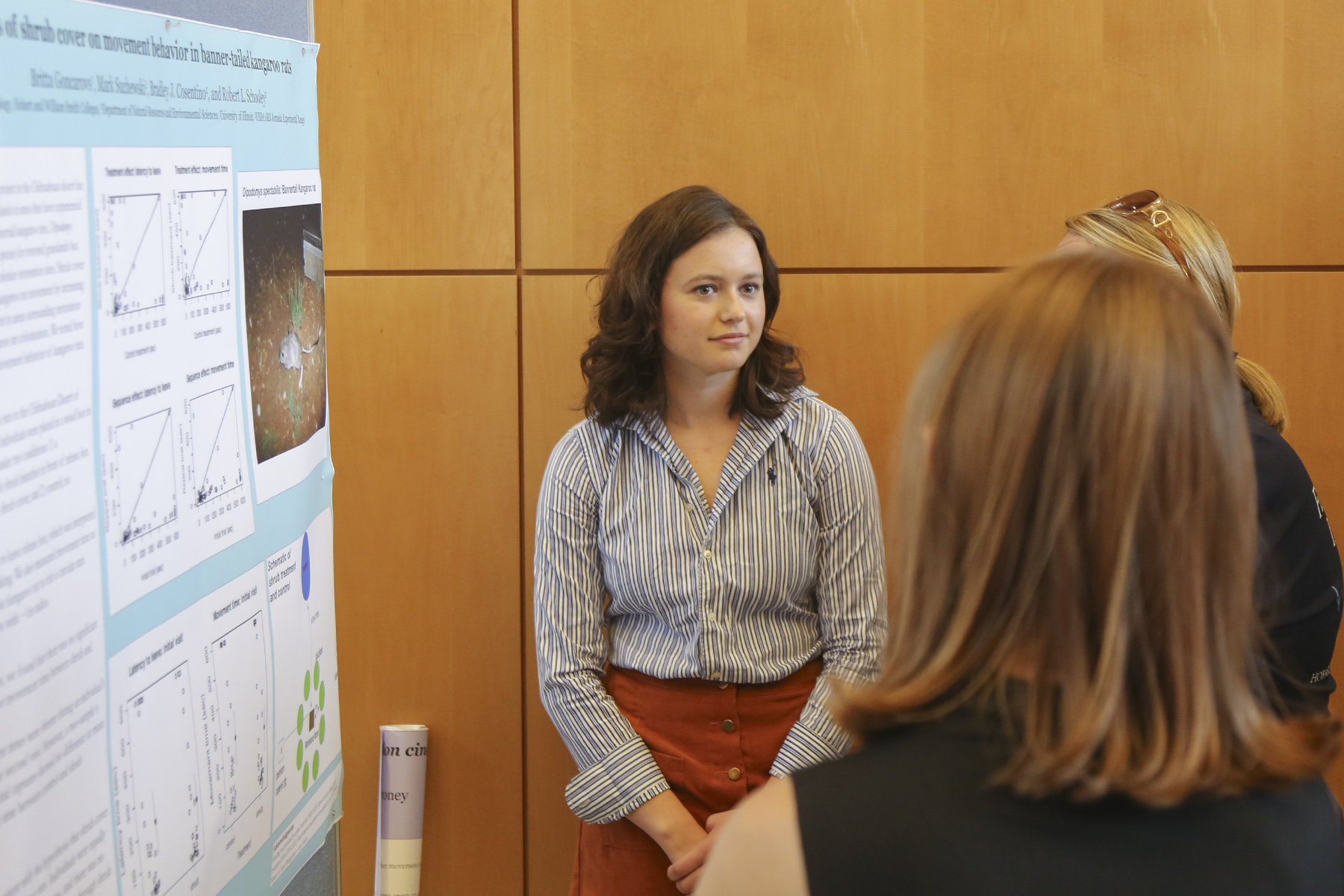 Britta Goncarovs '21 presents her research project titled, "Effects of shrub cover on movement behavior in banner-tailed kangaroo rats."
Britta Goncarovs '21 presents her research project titled, "Effects of shrub cover on movement behavior in banner-tailed kangaroo rats."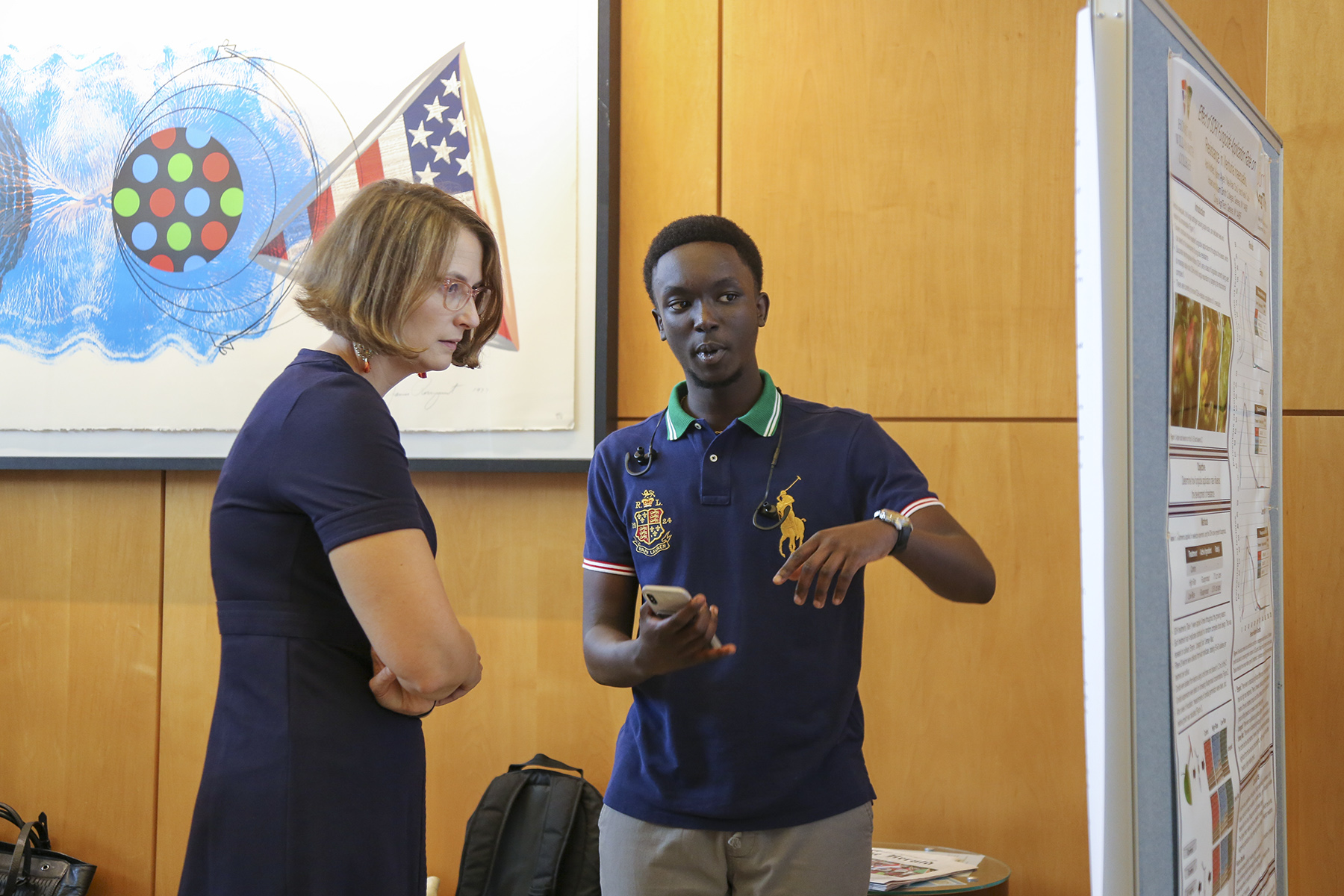 Jean-Luc Shyaka '21 discusses his research project titled, "Analysis of Multinational Corporations: A Case Study of Rwanda" with Associate Professor of American Studies Beth Bellanger.
Jean-Luc Shyaka '21 discusses his research project titled, "Analysis of Multinational Corporations: A Case Study of Rwanda" with Associate Professor of American Studies Beth Bellanger.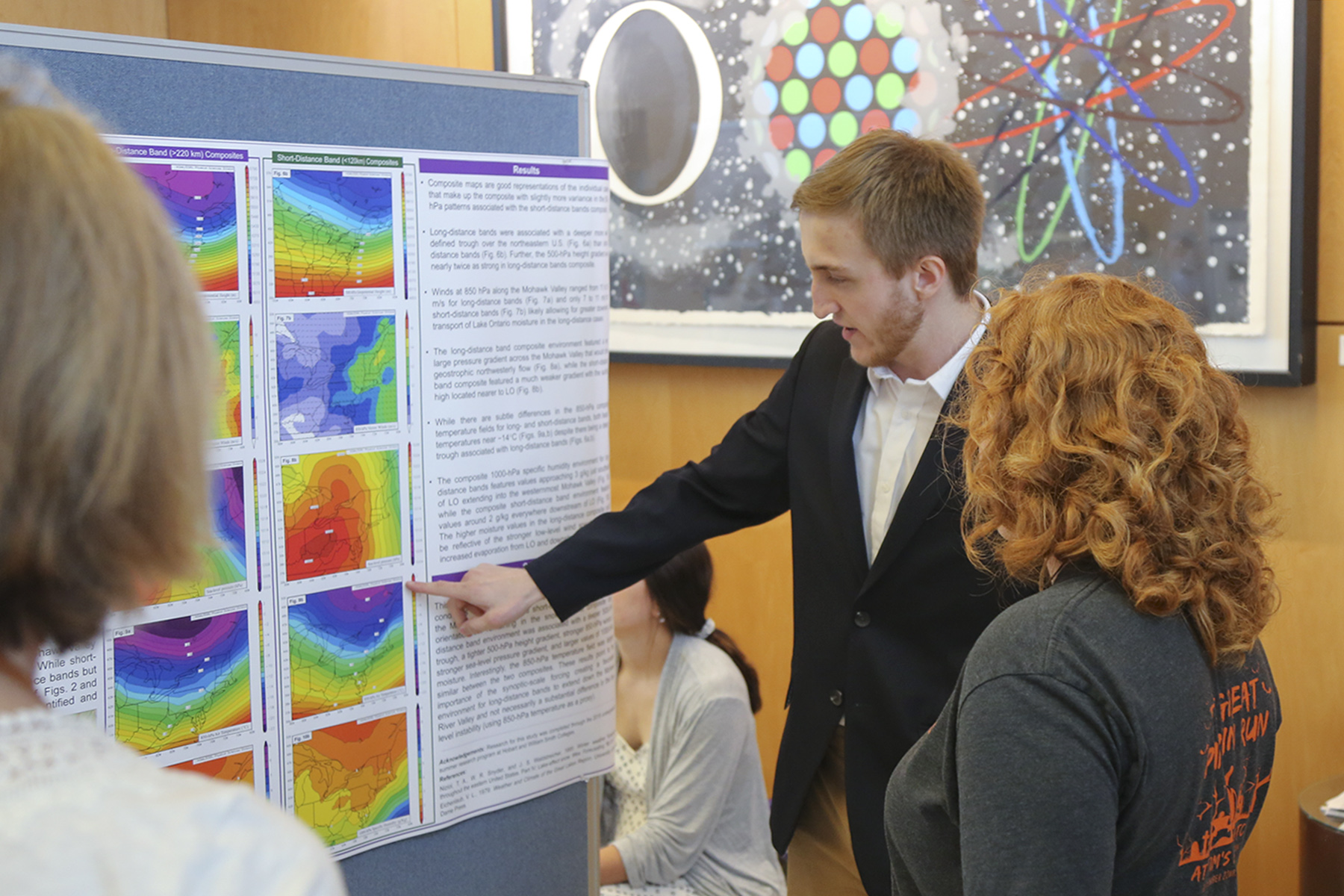 Patrick McMillan '21 presents his research project titled, "Atmospheric Conditions Favorable for Shore-Parallel Lake-Effect Snowbands Through the Mohawk River Valley."
Patrick McMillan '21 presents his research project titled, "Atmospheric Conditions Favorable for Shore-Parallel Lake-Effect Snowbands Through the Mohawk River Valley."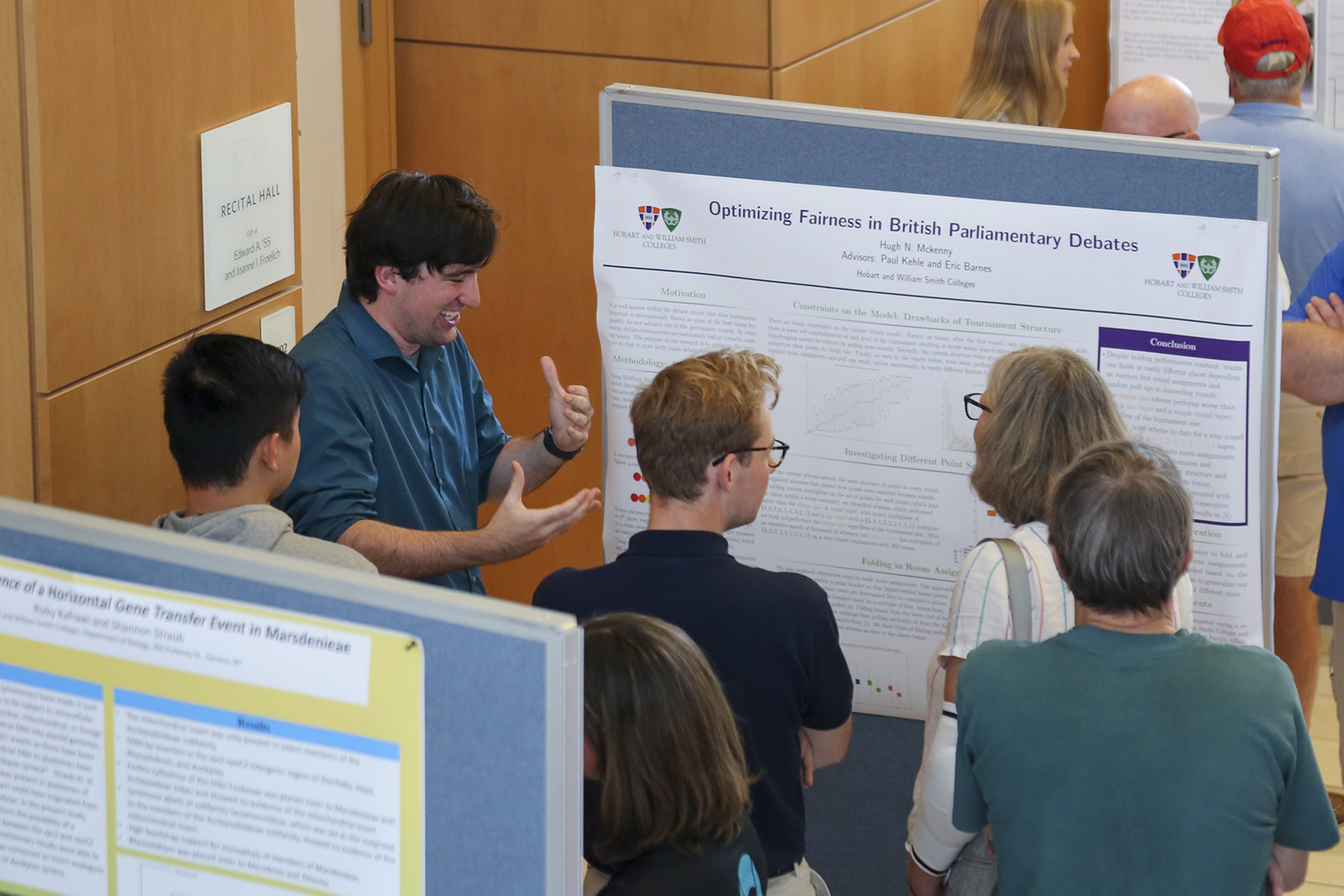 Hugh Nick Mckenny '20 poses for a photo with his research project "Optimizing Fairness in British Parliamentary Debates."
Hugh Nick Mckenny '20 poses for a photo with his research project "Optimizing Fairness in British Parliamentary Debates."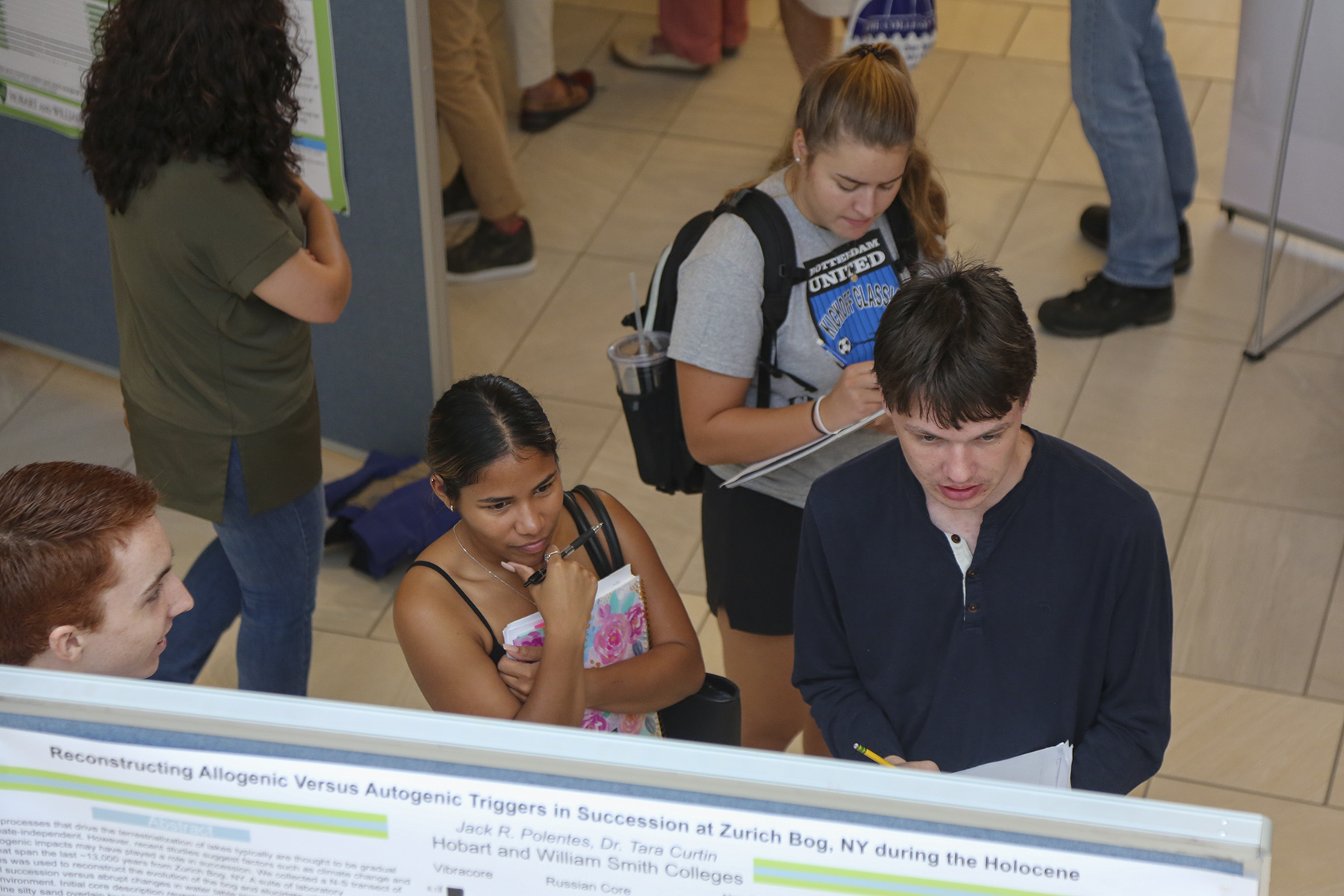
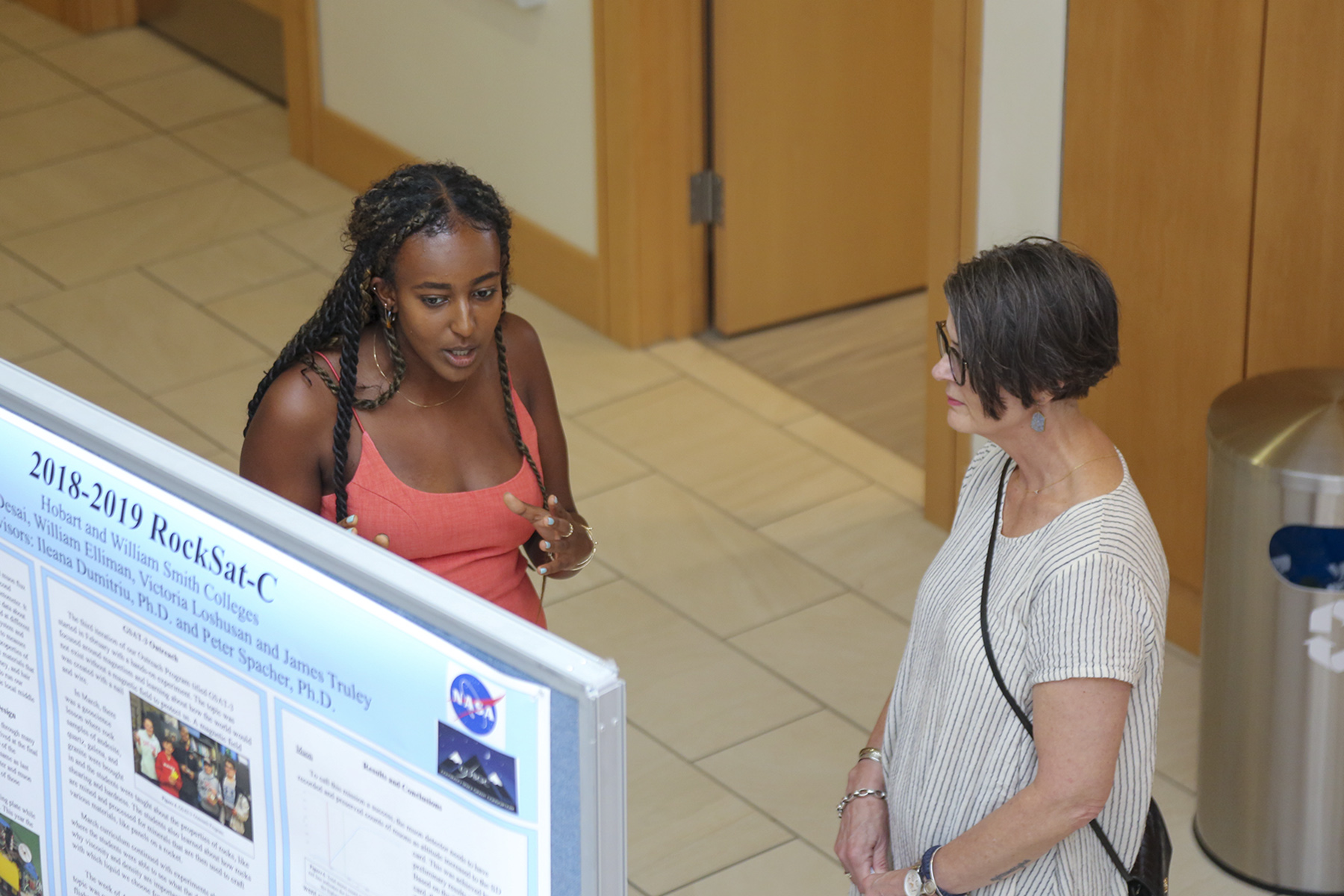 Yalemwork Teferra '21 discusses her research project titled, " Adolescent Black Male Identity Formation in a Racialized Society."
Yalemwork Teferra '21 discusses her research project titled, " Adolescent Black Male Identity Formation in a Racialized Society."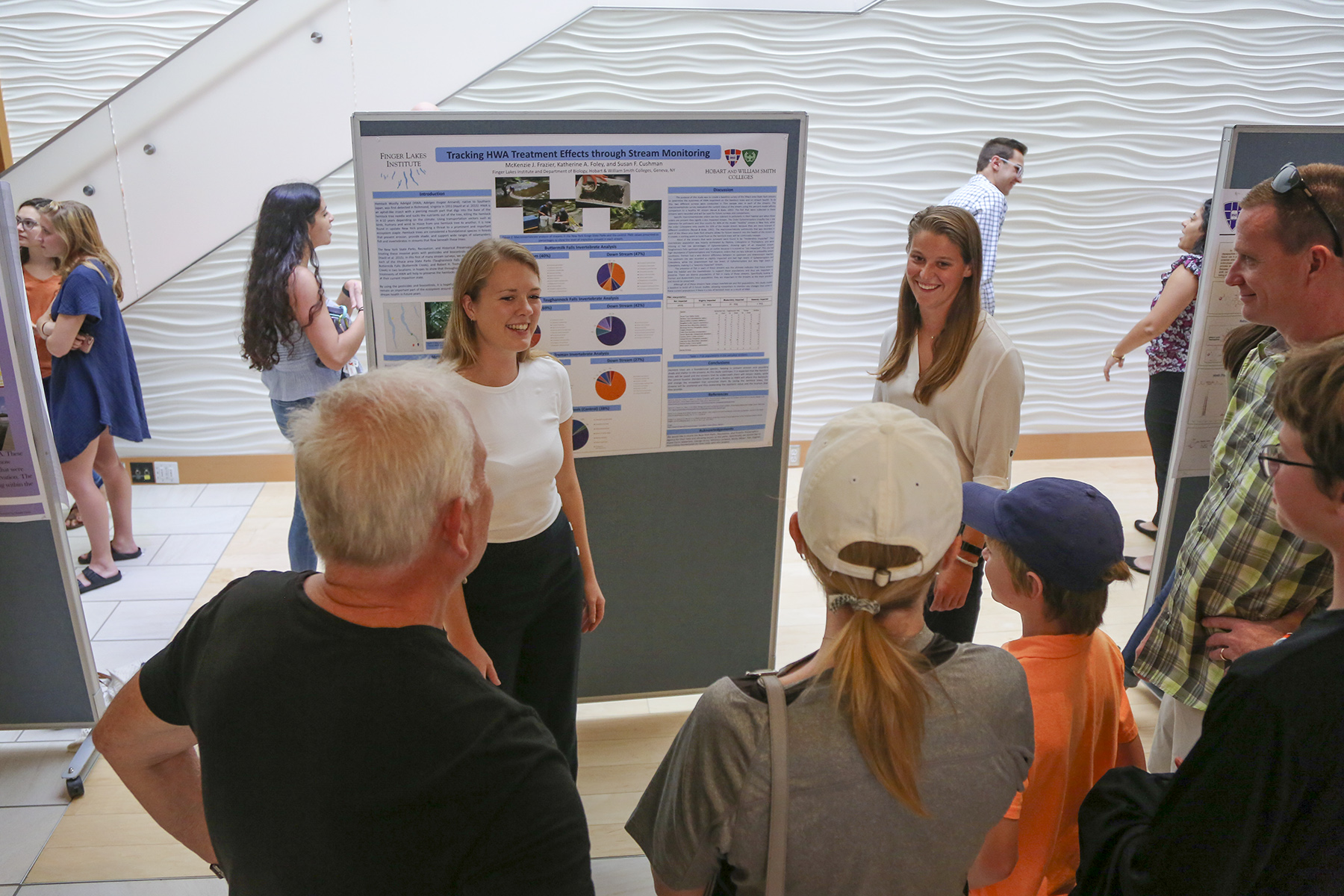 McKenzie Frazier '20 and Katherine Foley '20 present their research project titled, "Tracking HWA Treatment Effects through Stream Monitoring."
McKenzie Frazier '20 and Katherine Foley '20 present their research project titled, "Tracking HWA Treatment Effects through Stream Monitoring."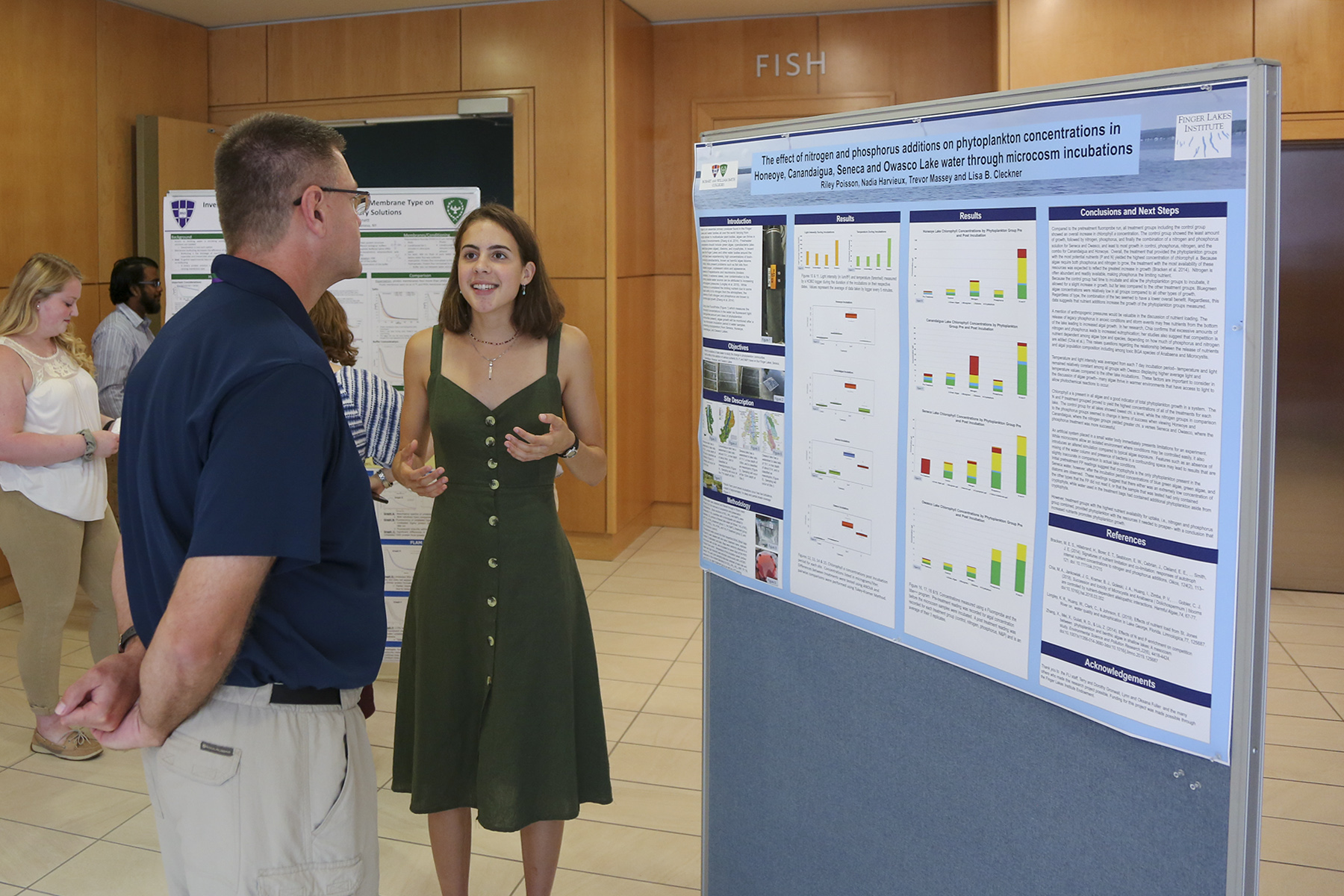 Riley Poisson '22 discusses her research project "The effect of nitrogen and phosphorus additions on phytoplankton concentrations in Honeoye, Canandaigua, Seneca and Owasco Lake water through microcosm incubations".
Riley Poisson '22 discusses her research project "The effect of nitrogen and phosphorus additions on phytoplankton concentrations in Honeoye, Canandaigua, Seneca and Owasco Lake water through microcosm incubations".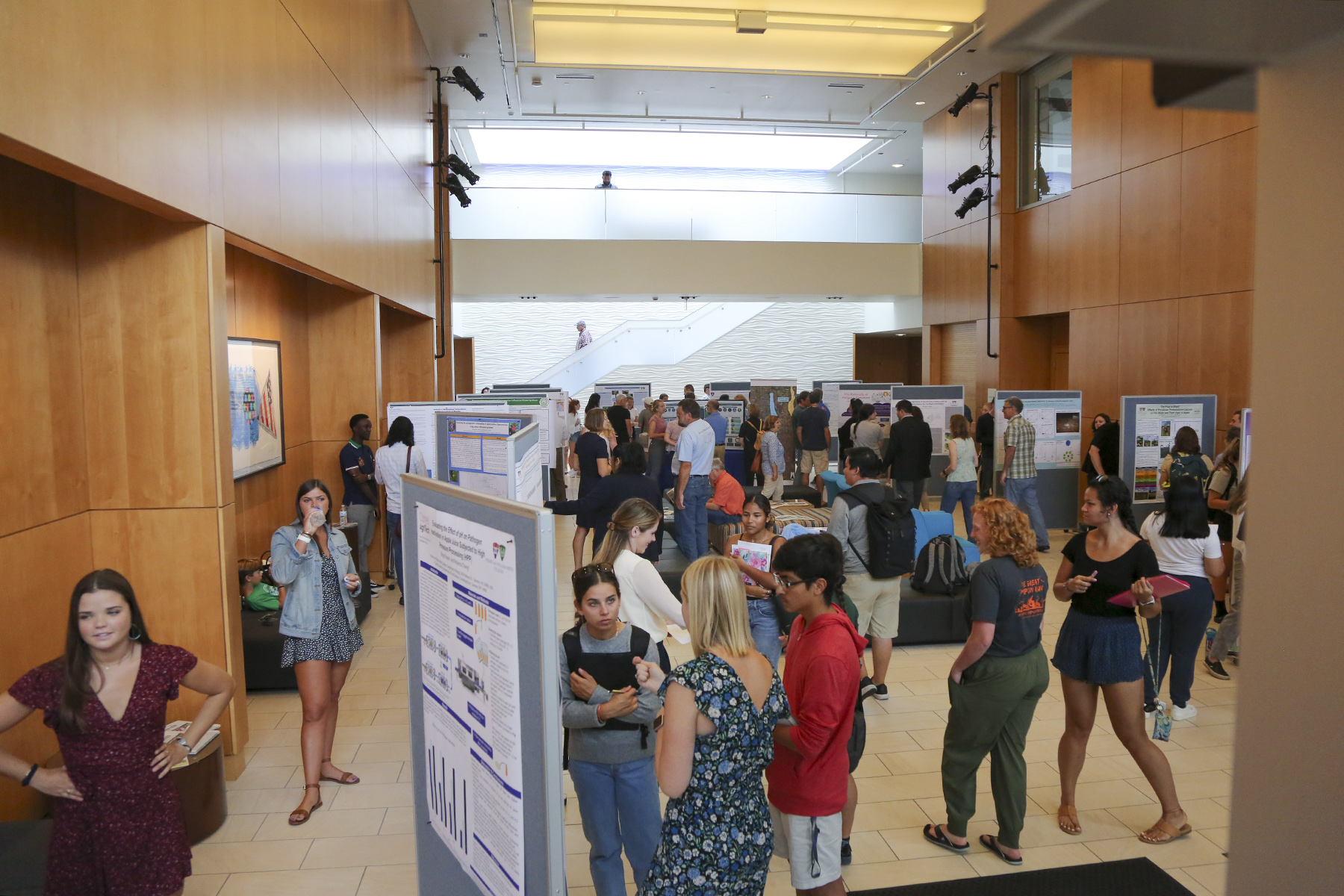 Students, faculty and parents fill the L. Thomas Melly '52 Lobby in the Gearan Center for the Performing for the Student Research Symposium during Homecoming and Family Weekend.
Students, faculty and parents fill the L. Thomas Melly '52 Lobby in the Gearan Center for the Performing for the Student Research Symposium during Homecoming and Family Weekend.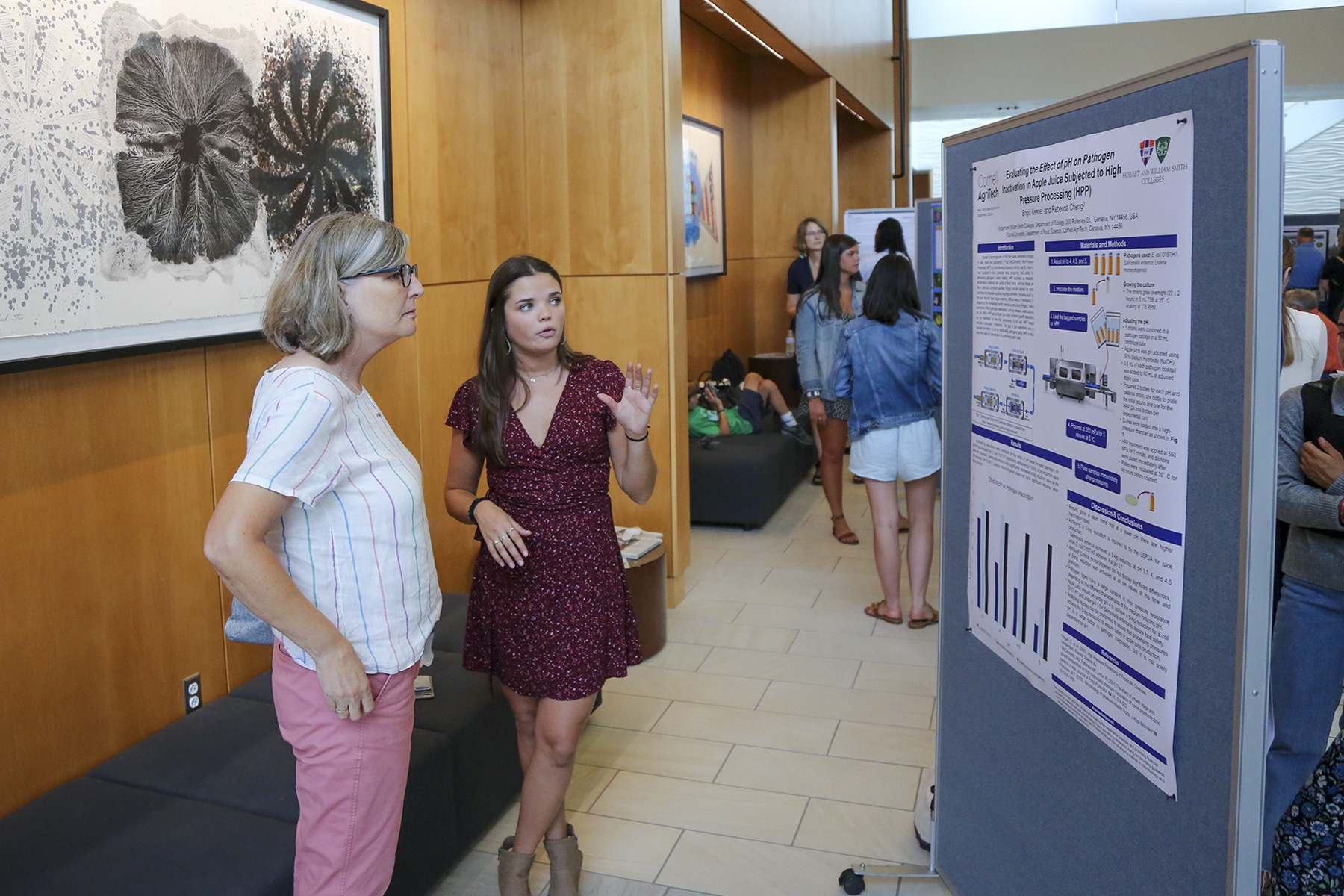 Brigid Keane '20 presents her research project "Evaluating the Effect of pH on Pathogen Inactivation in Apple Juice Subjected to High Pressure Processing (HPP)."
Brigid Keane '20 presents her research project "Evaluating the Effect of pH on Pathogen Inactivation in Apple Juice Subjected to High Pressure Processing (HPP)."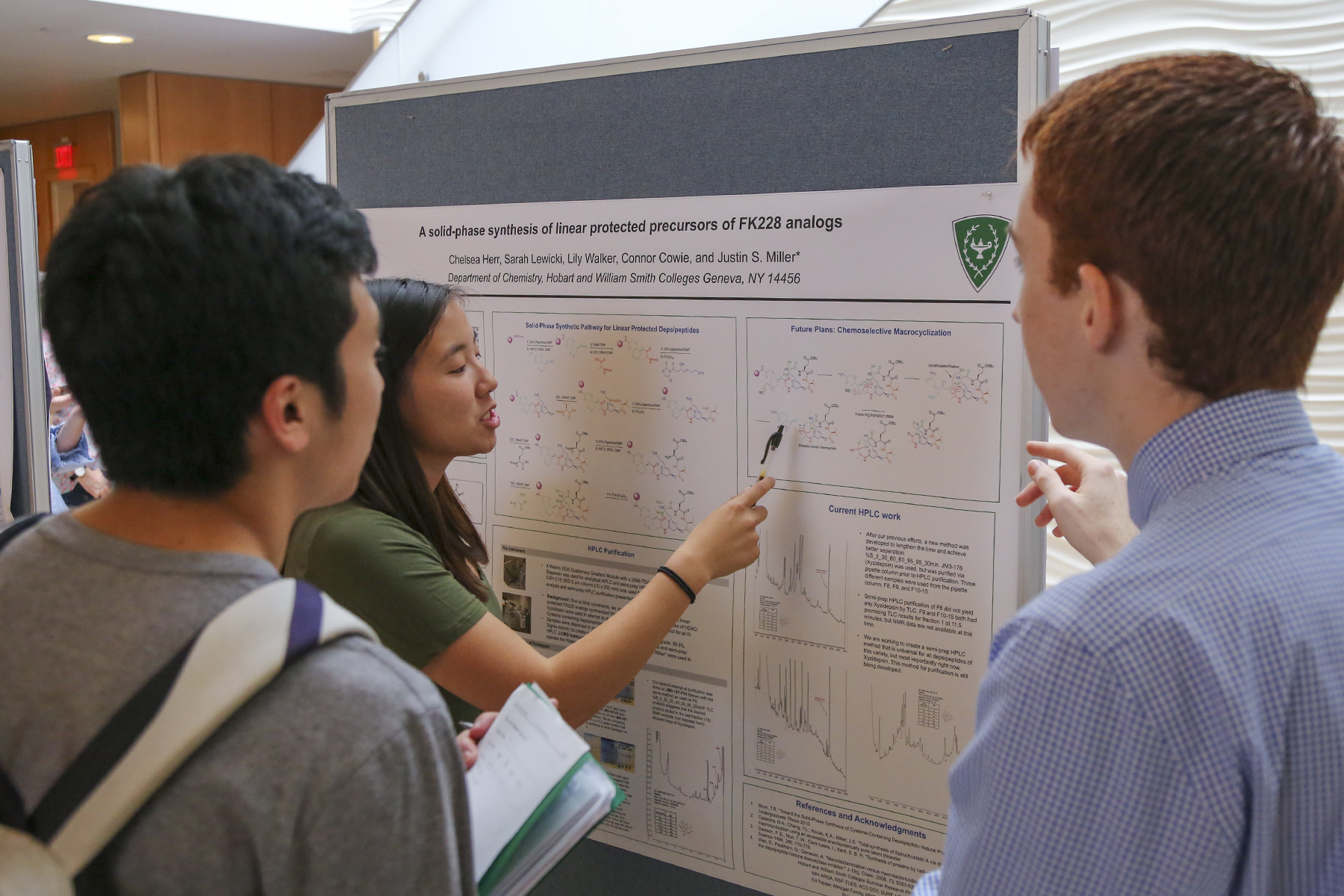 Lily Walker '22 discusses her research project titled, "A solid-phase synthesis of linear protected precursors of FK228 analogs."
Lily Walker '22 discusses her research project titled, "A solid-phase synthesis of linear protected precursors of FK228 analogs."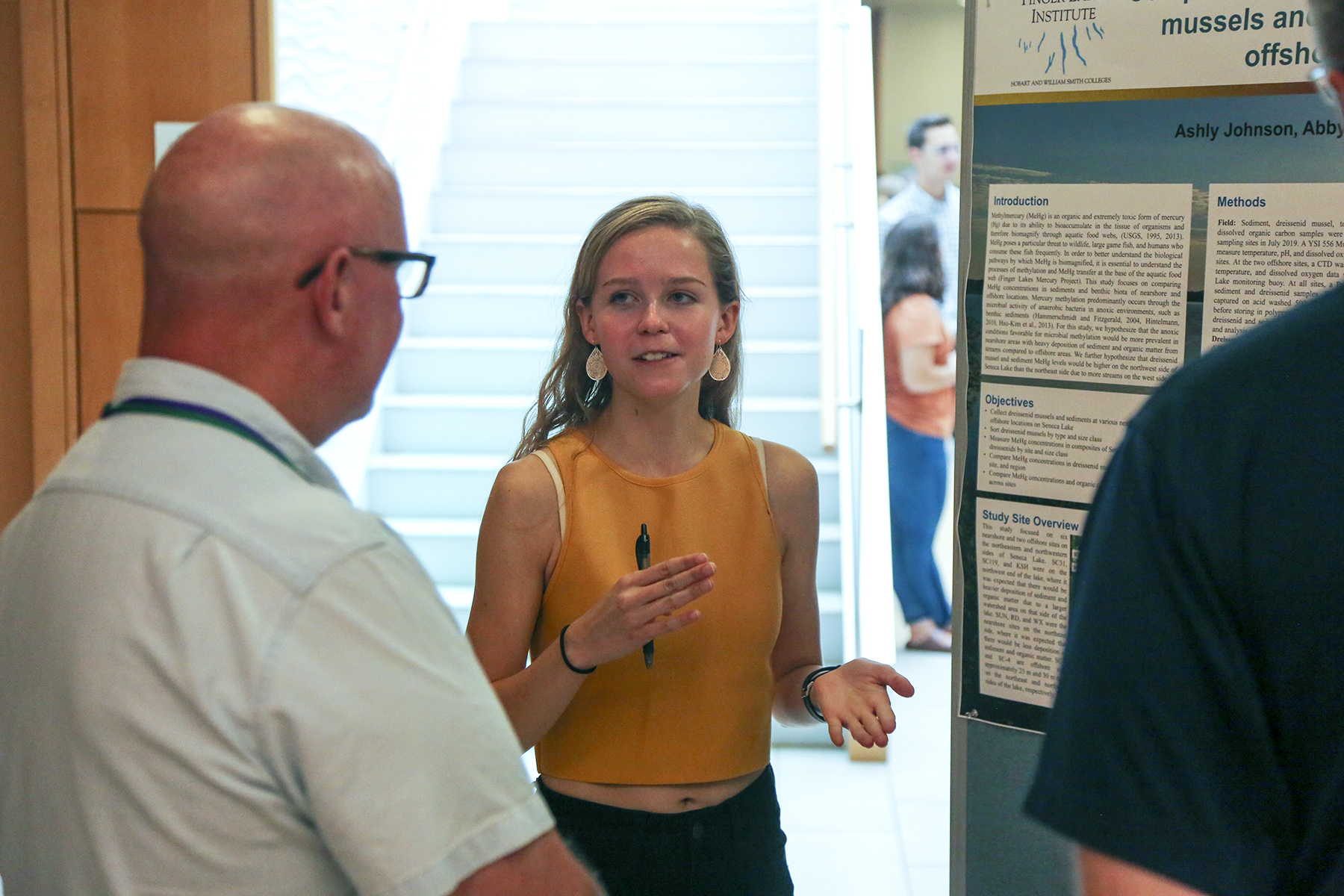 Ashly Johnson '22 presents her research project titled, "Comparing methylmercury levels in the dreissenid mussels and sediments of nearshore versus offshore areas of Seneca Lake."
Ashly Johnson '22 presents her research project titled, "Comparing methylmercury levels in the dreissenid mussels and sediments of nearshore versus offshore areas of Seneca Lake."
“I want to go to law school and become a lawyer,” Robelo-Lara says, adding that she intends to use her research as a framework for showing compassion to the people she works with. “I hate when people use the law as an excuse to be unjust.”
Robelo-Lara and Vergara became Belanger’s research assistants after taking her “Critical Family History” course. As part of an assignment, students were tasked with using public records, archives and other primary and secondary sources to retrieve their family histories. Vergara says the available research tools were not comprehensive for many students of color, affecting their ability to participate. The experience inspired them to collaborate with Belanger over the summer.
At the intersection of mathematical modeling and parliamentary debate, Nick Mckenny ’20 studied how debate competitions rank and organize teams into brackets. Utilizing mathematical modeling and computational discrete mathematics, Mckenny devised different methods of increasing fairness in the organization and judging debate tournaments. This is Mckenny’s second year of research and for him, it was markedly different from last year.
“[This year] was more focused not on proving things, but [finding] evidence to support an idea. So just having applied problems is really interesting but so is how you tackle real world issues,” he says. Mckenny’s research was completed in collaboration with Associate Professor of Philosophy and Director of HWS Debate Eric Barnes and Professor of Education Paul Kehle.
Katherine Foley ’20 and McKenzie Frazier ’20 collaborated in an effort to address a serious environmental disturbance within the ecosystems of New York State Parks. Their project analyzed the effects of various pesticide treatments in areas where an invasive species was prevalent to ensure that treatments were not damaging the surrounding forest ecosystem. They measured the unharmed areas and damaged sections by checking the populations of fauna in nearby streams and water sources. In working with Director of Introductory Laboratories Susan Flanders Cushman ‘98, both reflected on the value of collaborating with an HWS faculty member. Foley says working with Sanders also allowed her to complete increasingly “more difficult” lab assignments.
